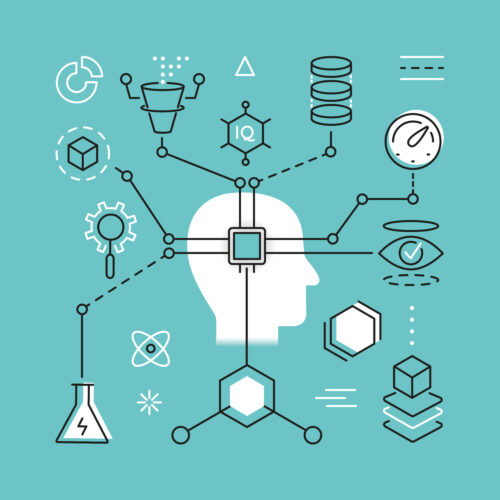Mental Models for Learning Design
 Modeling Decisions
Modeling Decisions
The world’s changing faster, and our ability to respond depends on our ability to adapt. It’s become clear that what will make the difference for organizations will be the ability to make decisions quickly in the face of increasing ambiguity. And I think the answer is mental models.
My point is fairly simple: I believe that what will make a difference to the success of organizations will not be the ability to recite facts, but instead the ability to determine courses of action in uncertain situations. Trouble-shooting, new product design, strategy, all are areas where you don’t know the answer when you start, but you have to make choices. Rote information and well-defined decisions will eventually be automated, but making creative decisions will remain the human strong suit for the foreseeable future.
The cognitive story
Mental models are models of the world. They are conceptual, in that they link individual concepts together into a coherent whole. They are also causal, as they explain why things happen. They also represent a part of the world; they are not complete but instead have sufficient richness to be useful.
Given the limitations of our brains, they also have some other characteristics. They are partial, in that there may be missing parts. They are also not completely accurate, but good enough. So, you may be able to diagnose a car problem with fuel or electricity without fully understanding fuel injection or electronic ignition.
One robust finding is that we do build them. If we see a phenomenon, or an occurrence, we will try to create an explanation. We build explanatory models of how things work, and why they happen. And it can be challenging, such as the sewing machine: how do those two threads get interwoven?
Another robust finding is once they’re built, they’re hard to eradicate. If a model, once built, is proven wrong, the human tendency is to patch it. People don’t ask “please, sir, may I have a new model?” Thus, it’s important to get on top of them early.
Models are the basis for making decisions. They’re mental simulations of “what happens if I…” As causal representations for how things work, they can be used to explain outcomes, and also to predict consequences. The proper model for a decision is to determine alternative choices of action, evaluate the outcomes of each, and then choose the one with the best outcome. Models give you a basis both choosing potential courses of action and evaluating the consequences of them.
Research has shown that much of our cognitive decision making isn’t done with conscious reasoning, but instead with our intuitions. To make models work best, the use of them must be automated to become below conscious thought, and to be used automatically. And this is a job for effective training.
Building models
So, how do we build a flexible ability to use models in decisions? The components are just as you know: model presentation, suitable examples, and lots of practice. But there are details that are critical.
To convey complex causal relationships can be a challenge. Text requires gradually building a mental model through a linear presentation, which can be challenging owing to our limited working memory. We want a prose recitation, but can we augment it to make it more accessible? What other ways can we convey it? Multiple representations are known to facilitate comprehension.
Jill Larkin and Herb Simon, cognitive scientists at Carnegie Mellon University wrote an article entitled “Why a Diagram is Worth 10000 words”, proposing that diagrams map conceptual relationships to spatial relationships I myself erred on the side of explaining a complex relationship in prose when documenting the research in my thesis. Fortunately, my Ph.D. advisor recognized the challenge and suggested a diagram. (It is, in fact, written up as an anonymous example in one of his books!)
Of course, if the nature of the relationship is dynamic, in that it changes over time, you might need a different format. Animations – animated diagrams – can be useful here. And tools to create them are getting ever easier to use.
Once you’ve presented models, learners need to see how they’re used. Examples are best suited as stories, telling the situation, the dilemma, the options considered, the choices made, and the outcome. Stories make sense, because our brains are wired to process them. Important elements include being clear about the underlying thinking and ideally showing backtracking and repair (this helps illuminate self-monitoring, an important meta-cognitive concept).
More specifically, examples need to annotate the thinking with the models. That is, the thought processes that accompany the choices that lead from problem to solution need to explicitly refer to the models, and show how the causal relationships were used to make the decisions. The relationship between the model and the context in the situation needs to be made clear. And, of course, multiple contexts should be used to help abstract the model from the specific context and show how the model can be re-instantiated in different situations.
Ultimately, of course, what’s needed is practice. In particular, sufficient practice to automate the use of the model in the context. That varies, depending on the complexity of the model, the specificity of the situations, and the frequency of use in the performance situation after the learning situation. Taking a 70:20:10 perspective, including the expectations for coaching and breadth of application after the learning experience helps plan for the full learning experience.
Learners need to be presented with situations where the model is applicable (and even ones where it’s not, if those boundaries are important), and given choices to make. Depending on the cost of failure, this may range from simply better written multiple-choice questions to a full immersive simulation game.
Given the fact that we’re talking about increasingly ambiguous situations, it may be hard to determine the contexts. However, the model that should guide the decisions should also support inferring the types of situations where the decisions could occur, and picking representative situations that span the space. These should be distributed across examples and practice situations to support appropriate transfer.
Using Models
Ultimately, it will be important to determine whether the models have been appropriately internalized. Of course, this happens naturally as a result of the practice, but you may well want to assess the knowledge of the model as well as the ability to apply that model to make decisions. However, the best test of the models is the ability to use it to predict and explain, so not only knowing the relationships but using them becomes clear.
Another useful approach may be to ask learners to actively represent the models, with concept mapping. Concept mapping involves creating explicit representations of the concepts and the links between them. They have been shown to be powerful adjuncts to other mechanisms to develop and assess conceptual understanding.
Models are, in my mind, the most powerful tool you can equip learners with. As part of the Ph.D. research I mentioned earlier, I explored analogical reasoning and mental models as a outcome of our powerful cognitive architecture. It’s been proposed that all thinking is inherently analogical, and regardless, it’s valuable for the purposes of accommodating our increasingly changing world. Research has supported the value of mental models in business decisions, so it’s time to get on top of this area for organizational success. I hope this mental model of mental models helps you in your decisions about learning design.

 Modeling Decisions
Modeling Decisions



